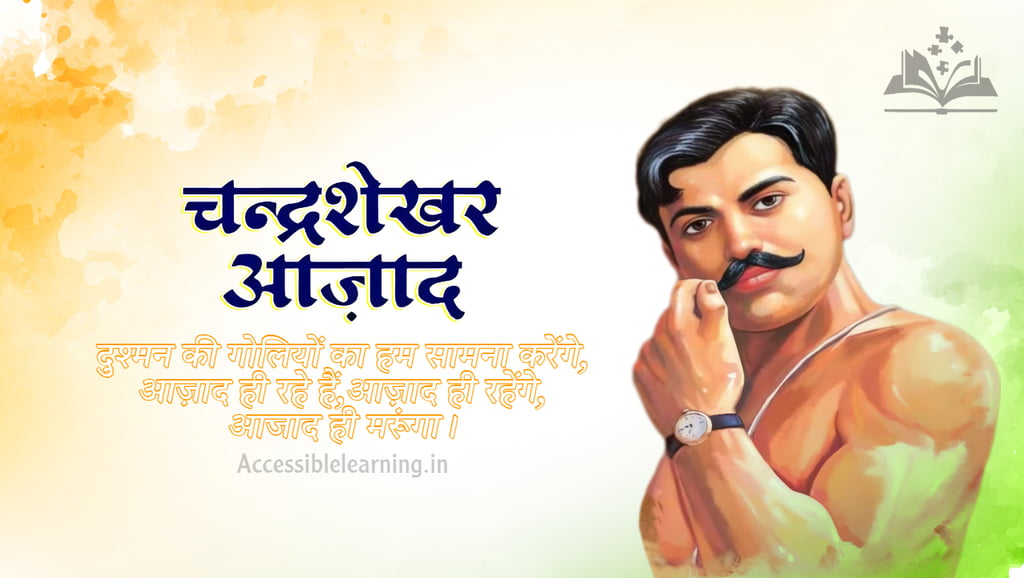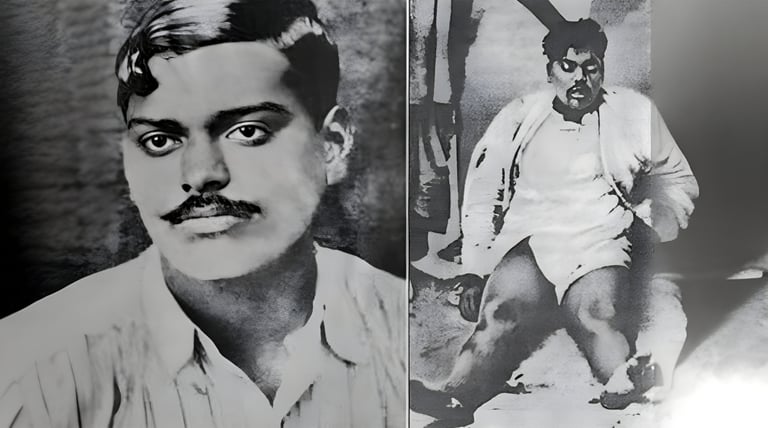
Chandra Shekhar Azad: The Indomitable Spirit of India’s Freedom Struggle!
Born on July 23, 1906 in Bhavra, Madhya Pradesh, Chandrashekhar Azad is one of India's most revered freedom fighters. His life and sacrifice symbolize the relentless pursuit of freedom and the courageous spirit of the Indian revolutionary movement. Known for his unflinching resolve and fearless leadership, Azad's contribution to India's struggle against British colonial rule continues to inspire and resonate deeply today!
INDIAN HISTORYTHE GREAT LEADERBIOGRAPHY/HISTORYBIOGRAPHY
Sachin K Chaurasiya
9/13/20246 min read


Chandrashekhar Azad Ji (चंद्रशेखर आज़ाद जी) was not just a revolutionary; he was a symbol of India's quest for freedom. Born in a period of intense political turmoil, his life was dedicated to liberating India from British rule. As a fearless leader, he not only led important revolutionary activities but also inspired countless others to join the movement. This in-depth exploration of Azad's life provides a comprehensive understanding of his contributions, his ideological evolution, and the legacy he left behind.
Early Life and Formative Years!
Chandrashekhar Azad was born on July 23, 1906, in Bhavra, a village in the princely state of Alirajpur (now in Madhya Pradesh). His father, Pandit Sitaram Tiwari, and mother, Jagrani Devi, were staunch Hindus, and the family was steeped in traditional values. Azad's early education was in Bhavra, but his admission to the Sanskrit Pathshala in Varanasi introduced him to the broader currents of Indian thought and nationalism.
The socio-political atmosphere of India during Azad's early years was tinged with the spirit of rebellion. The harsh measures adopted by the British after the First World War, especially the Rowlatt Act and the brutal Jallianwala Bagh massacre of 1919, deeply influenced the young Azad. These events lit a fire in him to actively participate in India's struggle for independence.
First Brush with the Independence Movement!
Azad's first significant involvement in the freedom movement came in 1921, when he joined Mahatma Gandhi's non-cooperation movement. At the mere age of 15, Azad demonstrated his passion by actively participating in protests and boycotting British goods. During one such protest, he was arrested by the British authorities. When he was brought before a magistrate and asked his name, he famously replied, "Azad (आजाद)" (independent); his father's name was "Swatantra (स्वतंत्र)" (freedom), and his residence was "jail (जेल)." This bold declaration earned him the name "Azad," by which he was known for the rest of his life.
Disillusionment and Shift to Revolutionary Ideals
The sudden suspension of the Non-Cooperation Movement in 1922 after the Chauri Chaura incident left many young nationalists disillusioned with Gandhi's strategy of non-violence. Azad, like many others, felt that a more direct and aggressive approach was needed to achieve independence. This disillusionment led him to join the Hindustan Republican Association (HRA), a revolutionary organisation founded by Ram Prasad Bismil, Ashfaqulla Khan, and others. The aim of the HRA was to organise armed resistance against the British, and Azad soon became one of its most active members. The organisation's manifesto called for the overthrow of British rule and the establishment of a "Federal Republic of the United States of India." Azad's participation in the HRA marked a turning point in his life, as he moved from peaceful protest to armed struggle.


Role in the Hindustan Socialist Republican Association (HSRA)
In 1924, the HRA was reorganised and renamed the Hindustan Socialist Republican Association (HSRA) to reflect its commitment to socialist principles and its vision for an independent, egalitarian India. Led by Azad, Bhagat Singh, and others, the HSRA focused on organising youth, raising funds for revolutionary activities, and carrying out acts of resistance against the British.
Azad's leadership was instrumental in shaping the strategies of the HSRA. He was known for his meticulous planning and often emphasized the importance of secrecy and discipline within the organization. Azad believed that the success of the revolution depended on the unity and determination of its members and worked tirelessly to instill these values in his comrades.
Key Revolutionary Actions
Kakori Conspiracy (1925): The most famous action carried out by the HSRA under Azad's leadership was the Kakori train robbery on August 9, 1925. The plan hatched by Azad and his associates involved robbing a train carrying government funds near Kakori in Uttar Pradesh. This money was intended to finance the revolutionary activities of the HSRA. The operation was executed with precision, but it also attracted the full might of British law enforcement. Several prominent members of the HSRA, including Ram Prasad Bismil and Ashfaqulla Khan, were arrested and later executed, while Azad managed to escape capture.
Assassination of Saunders (1928): Another important event in Azad's revolutionary career was the assassination of British police officer J.P. Saunders. The act was carried out to avenge the death of Lala Lajpat Rai, a respected nationalist leader who was injured during a peaceful protest against the Simon Commission in Lahore and later died of his injuries. Azad, along with Bhagat Singh and Rajguru, planned and executed the assassination of Saunders as a symbol of resistance against British oppression.
Assembly Bombing (1929): Azad was also involved in planning the bombing of the Central Legislative Assembly in Delhi on April 8, 1929. Bhagat Singh and Batukeshwar Dutt threw non-lethal bombs into the assembly chamber in protest against the repressive laws. Azad's role was to ensure the safe escape of his comrades, but Bhagat Singh and Dutt decided to surrender to make a political statement. The incident brought the HSRA and its cause to the forefront of Indian politics.


Azad’s Ideological Beliefs and Vision for India
Chandrashekhar Azad was deeply influenced by socialist ideas and the global revolutionary movements of his time. He believed that true independence could only be achieved through the establishment of a socialist state that would ensure social and economic equality for all Indians. Azad's commitment to socialism is reflected in the HSRA manifesto, which called for the abolition of exploitative systems and the creation of a society based on justice and equality.
Azad was also a strong supporter of Hindu-Muslim unity, believing that communal harmony was essential for a united struggle against British rule. He worked closely with revolutionaries from different religious backgrounds, including Ashfaqulla Khan, whom he considered a close friend and comrade.
Final Days and Martyrdom!
Chandrashekhar Azad's life ended in a tragic but heroic manner on February 27, 1931. On that day, he was betrayed by an informer and cornered by British police at Alfred Park in Allahabad (now Prayagraj). Refusing to be captured alive, Azad engaged in a fierce encounter with the police. When he had only one bullet left, he used it to shoot himself, thus fulfilling his vow to remain "azaad" (free) and never fall into British hands.
Azad's death was a major setback for the revolutionary movement, but it also stirred nationalist sentiment across India. His courage and sacrifice inspired many to continue the fight for independence.
Legacy and Commemoration
Chandrashekhar Azad's legacy is etched in the history of India's freedom struggle. He is remembered as a fearless leader who embodied the spirit of resistance and self-sacrifice. Several institutions, parks, and schools across India are named after him to ensure that future generations remember his contributions.
Alfred Park, where Azad made his last stand, was renamed Chandrashekhar Azad Park in his honor. A statue of Azad now stands at the spot where he fell, a lasting tribute to his courage and dedication.
Literary and cinematic depictions of Azad’s life have kept his memory alive in the popular imagination. He has been portrayed in numerous films, plays, and books, each exploring different facets of his life and his role in the independence movement.
Impact on Future Generations
Chandrashekhar Azad's impact on the Indian independence movement extended far beyond his own life. His actions and ideas influenced a generation of young revolutionaries who carried forward the struggle for independence. Azad's belief in the power of youth, his commitment to social justice, and his dedication to freedom still resonate with those who fight for freedom and justice.
Azad's life story is a powerful reminder of the sacrifices made by countless individuals in India's pursuit of independence. His legacy is a source of inspiration not just for Indians but for all those who believe in the values of freedom, equality, and justice.
Chandrashekhar Azad Ji (चंद्रशेखर आज़ाद जी) is one of the most iconic figures of India's freedom struggle. His life, which embodied unwavering courage, deep commitment to freedom, and supreme sacrifice, continues to inspire and influence people around the world. When we honor his legacy, we remember not only his revolutionary actions but also the ideals and principles that guided his life. Azad's story is a testament to the enduring power of the human spirit in the face of oppression, and his legacy will continue to inspire generations to come in their pursuit of justice and freedom.
Subscribe To Our Newsletter
All © Copyright reserved by Accessible-Learning Hub
| Terms & Conditions
Knowledge is power. Learn with Us. 📚


